-

新人教版高中英语必修2Unit 4 History and Traditions-Listening&Speaking&Talking教案二
Listening and Speaking introduces the topic of “Take part in a youth project”. The listening text is an interview about "sharing views on historical sites". Through listening to a dialogue between Chinese and foreign students on the way to the Confucius Temple, students can understand their views on the Confucius Temple, Confucius, Confucius' descendants and Confucius' educational thoughts, so as to realize and think about the profound influence of Confucius and his thoughts on Chinese historical tradition. At the same time, the dialogue naturally integrates English idioms and mentions Shakespeare, the British playwright, so as to provide language materials and context for students to understand English idioms and related cultural allusions, as well as to compare Chinese and foreign cultures, which is helpful for students to understand and express the language such as history, tradition, culture and custom significant impact.Text analysis: listening text is a dialogue between a British student and a Chinese student when he goes to the Confucius Temple. When William, a British student, visited the Confucius Temple, he asked Xiao Kong, a Chinese student, for directions. Xiao Kong was just going to the Confucius Temple to meet with the members of the research group, so they went together and exchanged their views on the Confucius Temple, Confucius, Confucius' descendants and Confucius' educational thoughts. From the perspective of foreign tourists, this paper describes their thoughts on Confucius, the great son of Confucius, who had a profound impact on Chinese history and cultural tradition, and his education.Listening and Talking introduces a visit to a historic tourist destination. Tourism is a common way to understand a country's history, culture, and customs and so on. Students listen to the dialogue between Xiao Yan, a youth hostel Usher, and Paul, a backpacker, to learn about Pingyao's famous historical and cultural attractions and Paul's travel experience and experience as a foreign tourist.

新人教版高中英语必修2Unit 5 Music-Discovering Useful Structures教案二
4. When he got absorbed in his world of music, he felt as if he could “see” the beauty of the world around him, like he had in his previous life.P·P as adverbial: _________________________________________________________________.Function: _______________________________________________________________________.Step 5 Solid Complete the passage with the words in brackets in their correct forms.Well known as a successful band, the Impact members show quite a few striking qualities. They never ever give up. When _____________(question) by the media, they are not _____________(discourage) and practise even harder. They are improving themselves by attending several master training class. They are united. _____________(fill with) team spirit, they act as a whole, always aiming for glory. Step 6 Difference and similarity from -ingObserve the following examples.1. He went out, shutting the door behind him.=He went out, ________________________________________________________.2. Not knowing what to do, he went to his parents for help.=__________________________________________, he went to his parents for help.Similarity: _______________________________________________________________________________________________________________________________________________________.Difference : _______________________________________________________________________________________________________________________________________________________.Step Practice1. ________ in a hurry, this article was not so good. 因为写得匆忙, 这篇文章不是很好。2. ________ carefully, he found something he hadn’t known before. 他仔细读书时, 发现了一些从前不知道的东西。3. ________ why he did it, the monitor said it was his duty. 当被问及他为什么要这么做时, 班长说这是他的职责

新人教版高中英语必修2Unit 5 Music-Listening&Speaking&Talking教案
choir memberspeople to run food stands people to sell festival ticketspeople to sell music CDspeople to set up equipmentmusical performersStep 2: Listen to the announcement again and answer the questions. ? 1. What kind of songs will Grace Davis sing at the festival?? 2. Who can try out as a performer?? 3. What can those who think they do not have musical talent do?? 4. How can students volunteer to take part?? Talking about preferences:? Would you prefer doing ..?? What would you prefer to do?? Would you rather do .... or ….?? What would you rather do?? I'd prefer .... to ..? I'd rather have ... than .. Step 3: Speaking ProjectWork in groups. Role-play the conversation or make a new one.? Debbie: Where have you been? You missed the announcement about the music festival.? John: I was at the doctor's office. Music festival?? Frank: Yes, it's going to be next month on the school sports field. John, you can play the piano. How about playing it at the festival?? John: Well, I'd rather play the violin. I can play Liang Zhu.? Frank: Wow! Sounds good. What about you, Debbie? ? Debbie: Actually, I don't have much musical ability. I'd prefer just to help out with the crowds.? Frank: You can sell tickets or work at a food stand.? John: So can I assume that the aim of the festival is to raise money?? Debbie: Yes. All of the money will go to charity.

新人教版高中英语必修2Unit 5 Music-Listening and Speaking教案
This lesson is about music. Students can classify the types of music through the instruments and its sound and can talk about their preferences about music, even join some activities and play a role in them according to their musical talents. On the basis, they are guided to use the languages to express their preferences and some plosive sounds and their rules.1. Classify the music types through the instruments and its sound.2. Listen and understand what the speakers’ preferences are and the reasons; talk about their own preferences and give their own reasons, using these sentences: “What kind of music do you like? And why? “ “Because it makes/gives me energy/peaceful.../touches my heart...”.3. Learn some plosives and the rules.4. Join some activities and play a role in them according to the talents. 1. Listen and understand what the speakers’ preferences are and the reasons;2. talk about their own preferences and give their own reasons, using these sentences: “What kind of music do you like? And why? “ “Because it makes/gives me energy/peaceful.../touches my heart...”.3. Learn some plosives and incomplete plosives and its rules.Step 1 Lead inPoint at the pictures on P50 and ask Q1: What are the people doing in the pictures below?Q2: What kind of music they are?Then play the MP3s one by oneStep 2 ListeningTask 1: A reporter from the school newspaper is interviewing students about music. Listen to the interviews. Draw lines between the words to make complete sentences. Some words will not be used.

新人教版高中英语必修2Unit 5 Music-Reading and Thinking教案二
1. Get basic information about Eric; read deeply to understand the history and development of the virtual choir.2. Understand what the function of the virtual choir is and how to make a virtual choir.3. Understand the meaning of some languages in the context of the text through question guidance, such as “Many people do not have close friends or contacts who have the same interest in music.” and so on.Step 1 Leading-in1. Answer the following questions.Q1:Do you know the Apps like Tik Tok and Quick Hand?Q2: Do you want to make a Tik Tok video or a Quick Hand video?2. Play a Tik Tok video Step 2: Understanding the title Q1:What does the title mean ?Q2: Is the article a narration or exposition? Why? Q3: Can you change the title ? If you can, what is the title?Step 3: Scanning the whole text and getting the basic information1. Answer the following questions.Q1:Who came up with the idea for a virtual choir?Q2: Where did Eric studied the musical composition?Q3: What is his song?2. Find the main idea of each paragraph3. Deal with some new words.Step 4: Reading carefully to get detailed informationPara 1 How to make a virtual choir1. PreparationA. tools: a virtual camera; an Internet connectionB. hero/heroin: friends or some individuals who have the same interests2. Process
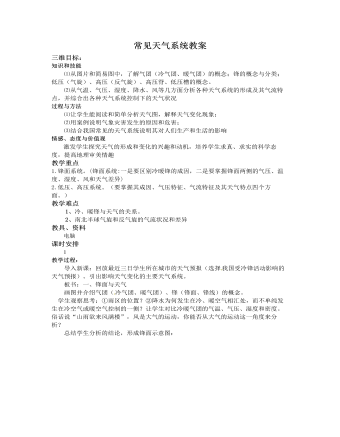
人教版高中地理必修1常见天气系统教案
知识和技能 ⑴从图片和简易图中,了解气团(冷气团、暖气团)的概念;锋的概念与分类;低压(气旋)、高压(反气旋)、高压脊、低压槽的概念。⑵从气温、气压、湿度、降水、风等几方面分析各种天气系统的形成及其气流特点,并综合出各种天气系统控制下的天气状况过程与方法 ⑴让学生能阅读和简单分析天气图,解释天气变化现象;⑵用案例说明气象灾害发生的原因和危害;⑶结合我国常见的天气系统说明其对人们生产和生活的影响情感、态度与价值观激发学生探究天气的形成和变化的兴趣和动机,培养学生求真、求实的科学态度,提高地理审美情趣教学重点1.锋面系统。(锋面系统:一是要区别冷暖锋的成因,二是要掌握锋面两侧的气压、温度、湿度、风和天气差异)2.低压、高压系统。(要掌握其成因、气压特征、气流特征及其天气特点四个方面。)
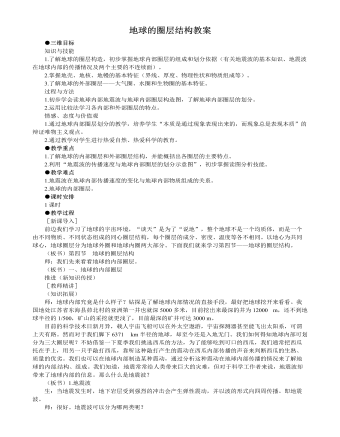
人教版高中地理必修1地球的圈层结构教案
师:很好。由于存在地球大气圈、地球水圈和地表的矿物,在地球上这个合适的温度条件下,形成了适合于生物生存的自然环境。人们通常所说的生物,是指有生命的物体,包括植物、动物和微生物。据估计,现有生存的植物约有40万种,动物约有110多万种,微生物至少有10多万种。据统计,在地质历史上曾生存过的生物约有5亿~10亿种之多,然而,在地球漫长的演化过程中,绝大部分都已经灭绝了。现存的生物生活在岩石圈的上层部分、大气圈的下层部分和水圈的全部,构成了地球上一个独特的圈层,称为生物圈。生物圈是太阳系所有行星中仅在地球上存在的一个独特圈层。课堂小结:地球所有的外部圈层是相互渗透、相互影响,甚至相互重叠的,在太阳和人类生活的参与下,整个地球生机盎然;同时,它们起着保护地球的作用,可以减弱太阳和宇宙辐射对地表的影响,减少宇宙中的陨石对地球表面的撞击。外部各圈中的物质运动和循环,是促使地表物质和形态演变的重要动力。
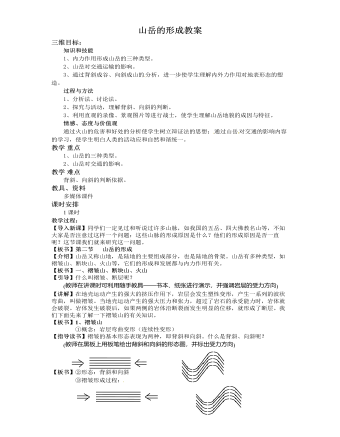
人教版高中地理必修1山岳的形成教案
【转折过渡】除了以上所说的褶皱山和断层山之 外,是否还有其他类型的山脉呢?试举一例说明。【学生思考后回答】有,如富士山属于火山。【教师总结】同学们回答的很好,还有火山,那么火山是如何形成的呢?这就是我们要研究的下一个问题。【板书】3、火山【指导读书】请同学们阅读教材P81思考:①玄武岩高原和火山有什么联系与区别? ②火山由哪几部分构成的?③火山的规模是否相同?【学生回答】①联系:玄武岩高原和火山都是由于处于地下深处的岩浆,在巨大的压力作用下,有时候会沿着地壳的薄弱地带喷出地表而形成的。区别:玄武岩高原是岩浆沿着地壳的线状裂隙流出,往往比较宽广。如哥伦比亚高原。火山是岩浆沿着地壳的中央喷出口或管道喷出。如我国长白山的主峰。②火山由火山口和火山锥两部分组成。③火山的规模大小不一,大火山的相对高度可达4 000~5 000米,火山口直径为数百米;小火山的相对高度不及100米。
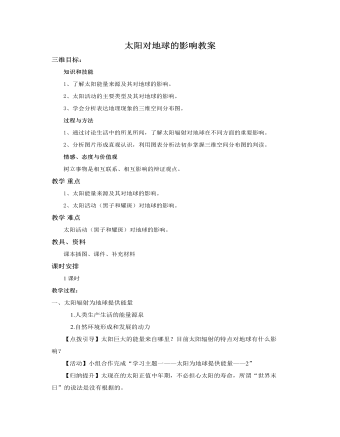
人教版高中地理必修1太阳对地球的影响教案
当时,不只发生了太阳风暴,同时还有其它的现象发生,导致灾难巨大。 如果,这些现象单独地发生,结果就会是另外一个样子。正是由于这些因素综合起来,1859年的太阳风暴,才在人类历史上留下了浓墨重彩的一笔。太阳磁暴开始干扰通信日本卫星首个被“击中”日本航天机构29日声明,受强烈的太阳磁暴影响,28日晚,日本“儿玉(Kodama)”通讯卫星信号中断。 据美联社报道,在太阳黑子活动减弱后,“儿玉”通讯卫星恢复正常运转。 美欧研究人员28日发布新闻公告称,太阳当天发生了一次强烈的耀斑爆发,预示着新一轮太阳风暴将在今后一两天内抵达地球,地球上的通信等设施可能会因此受到部分干扰。与这次耀斑爆发相伴,太阳表面还产生了一股强大的日冕物质喷射,方向几乎直冲地球。研究人员说,喷射产生的带电粒子流正以约每小时750万公里的速度奔地球而来,其与地球磁场作用后可能会形成比较强烈的地磁暴,使地球两极出现极光,并可能对卫星运行和通信等造成干扰。
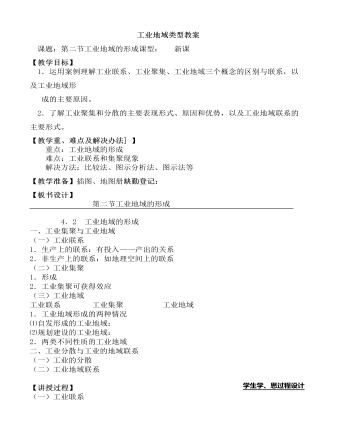
人教版高中地理必修2工业地域类型教案
1.生产上的联系:有投入——产出的关系工业生产的过程复杂,工序繁多,往往需要经过多家工厂的加工才能完成一种产品的生产过程。因此,在这些工厂之间就存在着产品与原料的联系。一家工厂生产的产品是另一家工厂的原料,这两家工厂之间就形成了工序上的工业联系。2.非生产上的联系:如地理空间上的联系布局在同一个工业区内,共同利用工业区的道路、供水、供电、通信等基础设施以及其他生产、生活服务设施,或者共同利用当地廉价的劳动力,形成了空间利用上的工业联系。我国许多地方的经济技术开发区就是建立在这种工业联系基础上的。(二)工业集聚1.形成具有工业联系的一些工厂往往近距离地聚集起来,形成工业集聚现象。2.工业集聚可获得效应(1)工业集聚可以加强企业间的信息交流和技术协作,降低中间产品的运输费用和能源消耗,进而降低生产成本,提高生产效率和利润,取得规模效益。

必修一牛顿第一定律教案
(二)?过程与方法? 4.?观察生活中的惯性现象,了解力和运动的关系? 5.?通过实验加深对牛顿第一定律的理解? 6.?理解理想实验是科学研究的重要方法? (三)?情感态度与价值观? 7.?通过伽利略和亚里士多德对力和运动关系的不同认识,了解人类认识事物本质的曲折性? 8.?感悟科学是人类进步的不竭动力
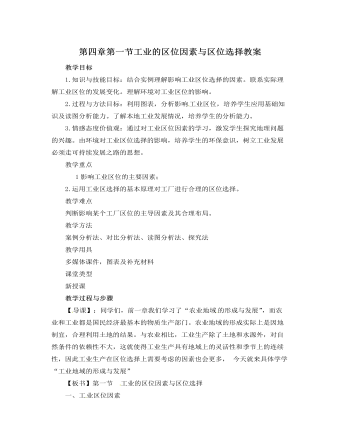
人教版新课标高中地理必修2第四章第一节工业的区位因素与区位选择教案
教学目标1.知识与技能目标:结合实例理解影响工业区位选择的因素。联系实际理解工业区位的发展变化。理解环境对工业区位的影响。2.过程与方法目标:利用图表,分析影响 工业区位,培养学生应用基础知识及读图分析能力。了解本地工业发展情况,培养学生的分析能力。3.情感态度价值观:通过对工业区位因素的学习,激发学生探究地理问题的兴趣。由环境对工业区位选择的影响,培养学生的环保意识,树立工业发展必须走可持续发展之路的思想。教学重点1影响工业区位的主要因素;2.运用工业区选择的基本原理对工厂进行合理的区位选择。教学难点 判断影响某个工厂区位的主导因素及其合理布局。教学方法 案例分析法、对比分析法、读图分析法、探究法教学用具 多媒体课件,图表及补充材料课堂类型
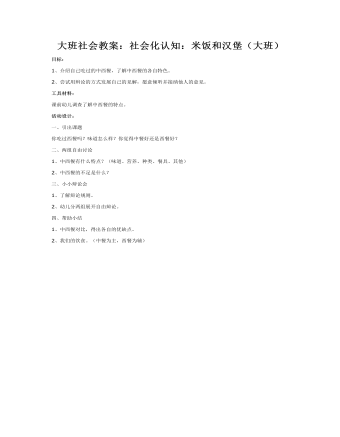
大班社会教案:社会化认知:米饭和汉堡(大班)
2、尝试用辩论的方式发展自己的见解,愿意倾听并接纳他人的意见。工具材料:课前幼儿调查了解中西餐的特点。活动设计:一、引出课题你吃过西餐吗?味道怎么样?你觉得中餐好还是西餐好?
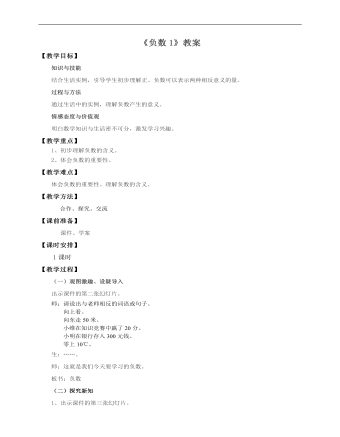
小学数学人教版六年级下册《第一单元第一课负数例1例2》教案说课稿
(一)观图激趣、设疑导入 出示课件的第二张幻灯片。师:请说出与老师相反的词语或句子。向上看。向东走50米。小维在知识竞赛中赢了20分。小明在银行存入300元钱。零上10℃。生:……。师:这就是我们今天要学习的负数。板书:负数(二)探究新知1、出示课件的第三张幻灯片。师:请大家仔细观察上图,你发现什么问题?学生以小组为单位交流。学生以小组为单位汇报交流结果。生:0℃表示什么意思呢?生:3℃和-3℃表示的意思一样吗?师:小组内交流解决上述问题。学生以小组为单位探究交流。学生以小组为单位汇报探究交流结果。老师对学生汇报给予适当的评价。老师课件出示答案。师:0℃表示淡水结冰的温度,比0℃低的温度叫零下温度,通常在数字前加“-”(负号),如-3 ℃表示零下3摄氏度,读作负三摄氏度;比0℃高的温度叫零上温度,在数字前加“+”(正号),一般情况下可省略不写:如+3℃表示零上三摄氏度,读作正三摄氏度,也可以写成3℃,读作三摄氏度。
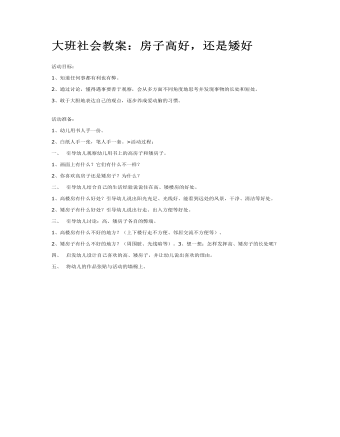
大班社会教案:房子高好,还是矮好
2、通过讨论,懂得遇事要善于观察,会从多方面不同角度地思考并发现事物的长处和短处。3、敢于大胆地表达自己的观点,逐步养成爱动脑的习惯。活动准备:1、幼儿用书人手一份。2、白纸人手一张,笔人手一套。>活动过程:一、 引导幼儿观察幼儿用书上的高房子和矮房子。1、画面上有什么?它们有什么不一样?2、你喜欢高房子还是矮房子?为什么?

幼儿园大班社会教案:认识文具和学具
活动准备 1、每人准备一只书包、铅笔盒、书本等。 2、情境表演:《两个小朋友》(小学生自己收拾文具的情景,一个会自己收拾,一个不会收拾)活动过程 1、认识学习用品,并知道它们的用途。 ——逐一出示书包、书、铅笔盒、本子、笔、尺、橡皮等用品,并讨论它们的用处。 ——形成学习用品的概念,知道这些都是小学生学习时需要用到的用品。

幼儿园大班社会教案:小铜人和小蜡人
活动准备: 《幼儿用书》人手一册。 调查表《长处和短处》。 活动过程: 1、倾听故事《小铜人和小蜡人》,感知理解故事内容。 教师引导幼儿打开《幼儿用书》至故事《小铜人和小蜡人》。 教师带领幼儿边看图边倾听故事。 教师:故事里有谁?小铜人有什么优点?小蜡人有什么优点? 教师:小铜人和小蜡人有缺点吗?有什么缺点呢? 2、启发幼儿探索并讲述自己的长处。 教师:小朋友,你有优点吗?你的优点是什么? 鼓励幼儿在集体面前展示自己的优点和长处(例如:会讲故事、会跳舞、会弹琴)
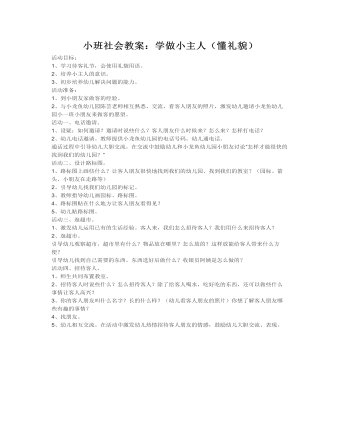
小班社会教案:学做小主人(懂礼貌)
2、培养小主人的意识。 3、初步培养幼儿解决问题的能力。 活动准备: 1、到小朋友家做客的经验。 2、与小龙鱼幼儿园陈芸老师相互熟悉、交流,看客人朋友的照片,激发幼儿邀请小龙鱼幼儿园小一班小朋友来做客的愿望。 活动一、电话邀请。 1、设疑:如何邀请?邀请时说些什么?客人朋友什么时候来?怎么来?怎样打电话? 2、幼儿电话邀请。教师提供小龙鱼幼儿园的电话号码。幼儿通电话。 通话过程中引导幼儿大胆交流。在交流中鼓励幼儿和小龙鱼幼儿园小朋友讨论“怎样才能很快的找到我们的幼儿园?”
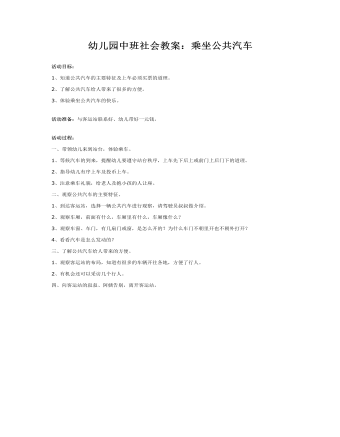
幼儿园中班社会教案:乘坐公共汽车
2、了解公共汽车给人带来了很多的方便。3、体验乘坐公共汽车的快乐。活动准备:与客运站联系好、幼儿带好一元钱。活动过程:一、带领幼儿来到站台,体验乘车。1、等候汽车的到来,提醒幼儿要遵守站台秩序,上车先下后上或前门上后门下的道理。2、指导幼儿有序上车及投币上车。3、注意乘车礼貌,给老人及抱小孩的人让座。
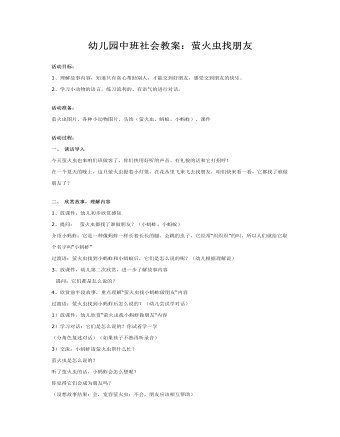
幼儿园中班社会教案:萤火虫找朋友
2、学习小动物的语言,练习流利的、有语气的进行对话。 活动准备: 萤火虫图片、各种小动物图片、头饰(萤火虫、蚂蚁、小蚂蚱)、课件 活动过程: 一、 谈话导入 今天萤火虫也来咱们班做客了,你们快用好听的声音、有礼貌的话和它打招呼! 在一个夏天的晚上,这只萤火虫提着小灯笼,在花丛里飞来飞去找朋友,咱们快来看一看,它都找了谁做朋友了? 二、 欣赏故事,理解内容 1、放课件,幼儿初步欣赏感知 2、提问: 萤火虫都找了谁做朋友?(小蚂蚱、小蚂蚁) 介绍小蚂蚱:它是一种像蚂蚱一样长着长长的腿、会跳的虫子,它经常“织织织”的叫,所以人们就给它取个名字叫“小蚂蚱” 过渡语:萤火虫找到小蚂蚱和小蚂蚁后,它们是怎么说的呢?(幼儿根据理解说)